Technologies
Bose QuietComfort Ultra Headphones Review: Sony Has Serious Competition
Bose’s new flagship QC Ultra Headphones make a very compelling alternative to both the Sony WH-1000XM5 and Apple AirPods Max.
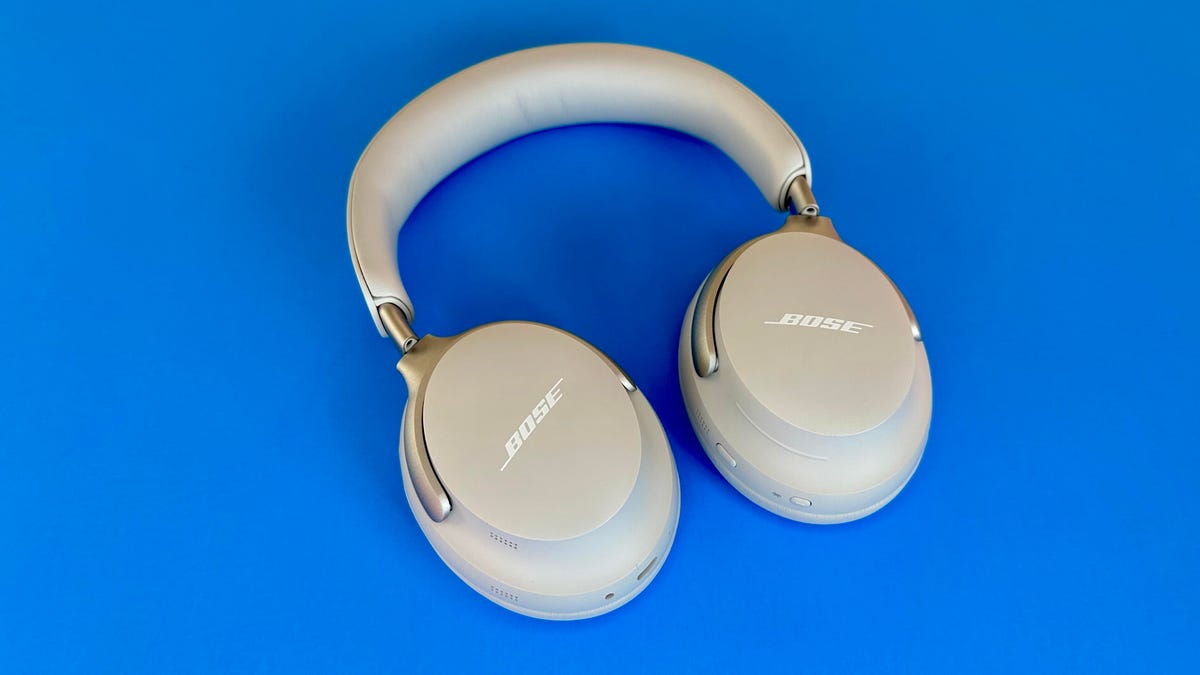
Back in 2015, Bose released a set of wired earbuds called the SoundTrue Ultra Earbuds that were among my favorite sounding Bose products. They were discontinued a few years ago, but Bose has brought back the Ultra name for its new flagship QuietComfort Ultra Earbuds ($299) and Quiet Comfort Ultra Headphones, which I’m reviewing here. At $429 (£450, AU$649), the latter are Bose’s most expensive headphones to date.
Not surprisingly, they’re very good. But are they better than Sony’s WH-1000XM5, Apple’s AirPods Max and some other «premium» noise-canceling headphones in this price range? Let’s get right into the review so I can try to answer that for you.
Bose QC Ultra Headphones design
The QC Ultra Headphones’ design is totally new. It’s sort of a cross between Bose’s previous flagship model, the Noise Cancelling Headphones 700 and the QuietComfort 45s, which have morphed into a new $350 model that Bose has simply named the QuietComfort Headphones.
The Headphones 700 had some metal parts, but the QC Ultra Headphones incorporate an aluminum yoke and arms that slide into the headband. Another upgrade is their dual-hinge design so they both fold up and fold flat, which allows them to have a smaller carrying case than the Headphones 700 and the Sony WH-1000XM5s, both of which only fold flat. Just be careful not to get your finger caught in the Ultra’s hinge, which I did a couple of times and got an unpleasant pinch.
The headphones feel durable and are surprisingly lightweight at 254 grams, just a couple of grams more than the Headphones 700. The Sony WH-1000XM5 weigh 249 grams, while the much heavier AirPods Max tip the scales at 385 grams.
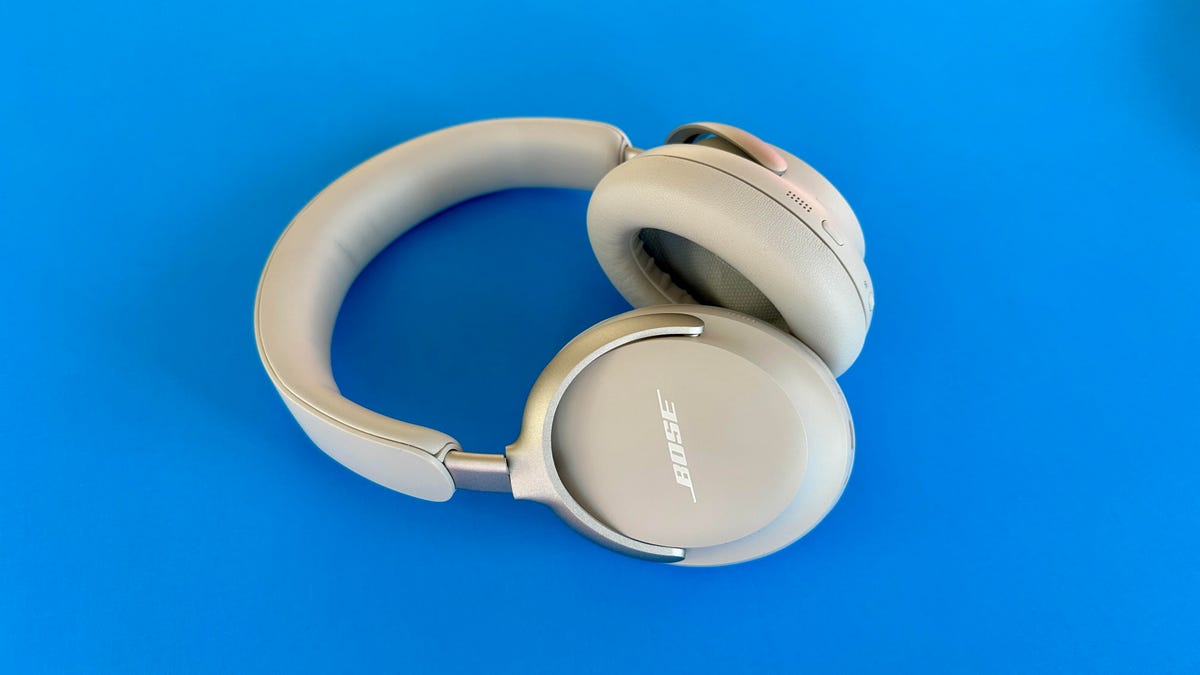
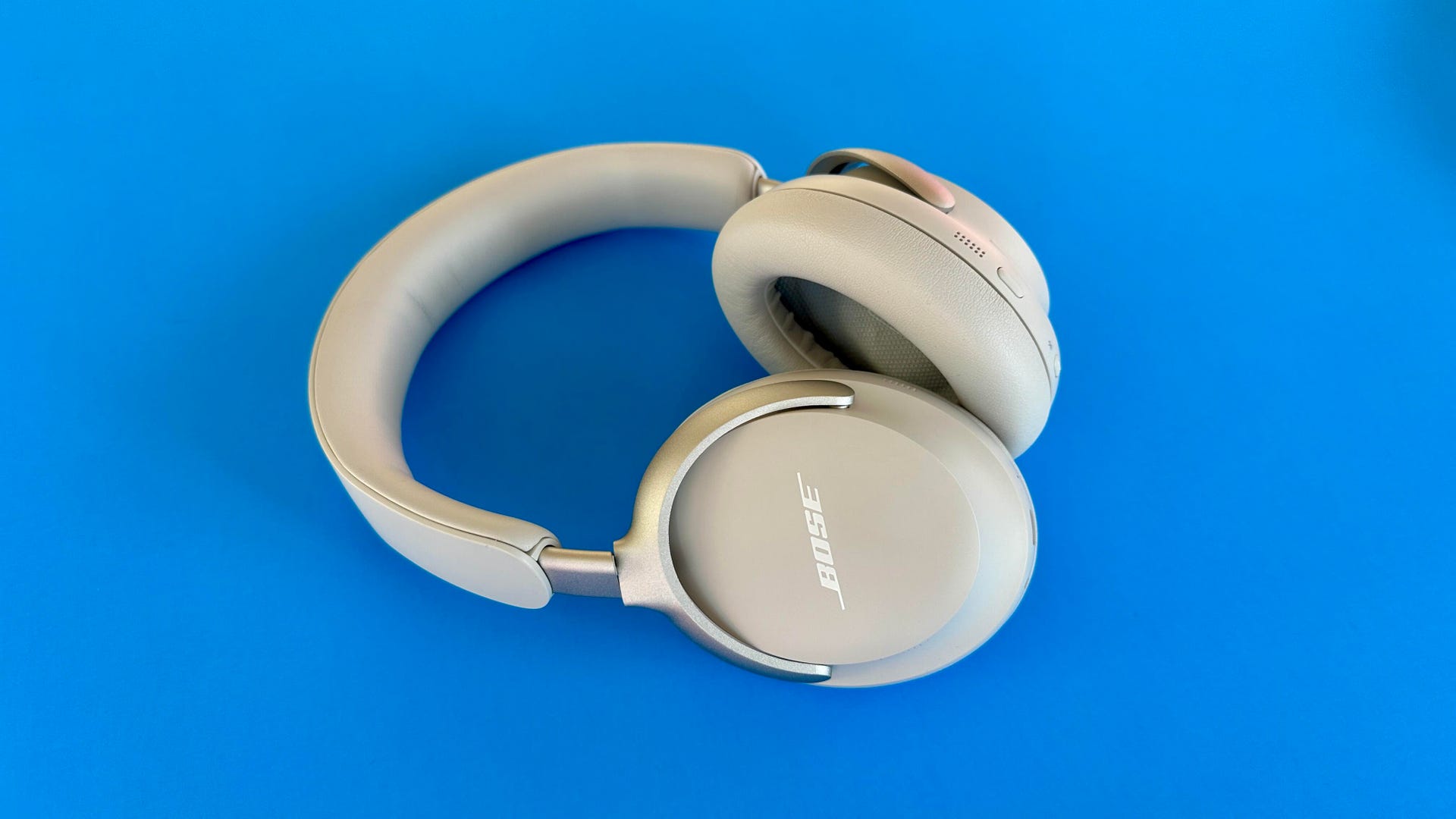
Bose reps told me the QC Ultras are designed to fit a wider range of head types and like other Bose headphones, they’re quite comfortable to wear. They did clamp slightly more than the Sonys, but I was able to wear them for a couple of hours straight without a problem. Like other over-ear headphones, they will steam up your ears if you wear them around in warm environments. It’s also worth mentioning that the black version of the headphones can end up showing some smudges if you have any grime on your hands or just have oily skin. The white smoke version doesn’t.
I like their controls. The QC Ultra Headphones feature a mix of physical control buttons along with a raised capacitive touch volume strip on the right ear cup that’s easy to reach and use by feel alone.
The main multifunction button on the headphones allows you to pause and play your audio with a single tap, skip tracks forward with a double tap and skip them back with a triple tap. Holding the button down lets you toggle through full noise canceling, an awareness mode and an immersion mode that activates full noise canceling along with Bose’s new spatial audio feature with head tracking that it calls Immersive Audio.
There’s also a touch-and-hold gesture for the volume strip that’s customizable as a shortcut. You can choose to map it to one of four functions: hear battery level, change Immersive Audio (cycle through still, motion and off settings), access your voice assistant and resume Spotify.
Bose QC Ultra Headphones features
While Bose mentions that both this over-ear Ultra model and its new QC Ultra Earbuds feature «world-class noise cancellation» — and they certainly do — the real feature it’s hyping this go-round is Immersive Audio, its custom version of spatial audio. Bose says Immersive Audio «goes beyond special effects and creates a wider, more spacious soundstage so your content becomes multi-dimensional and layered, regardless of the audio platform or device.»
Like other headphones that feature spatial audio — Apple’s latest AirPods, for instance — the QC Ultra Headphones and QC Ultra Earbuds have two spatial audio modes: one «still» mode without head-tracking engaged and a «motion» mode that uses head-tracking and allows the audio to «move with you, so it’s always in front of you.» Bose says it works with movies and any stereo track, but it’s really designed for music listening.
Using the Immersive Audio feature does widen the soundstage, creating the illusion that your audio is more outside your head. It works better with some tracks than others, but it does open the sound a bit, giving it an airier quality.

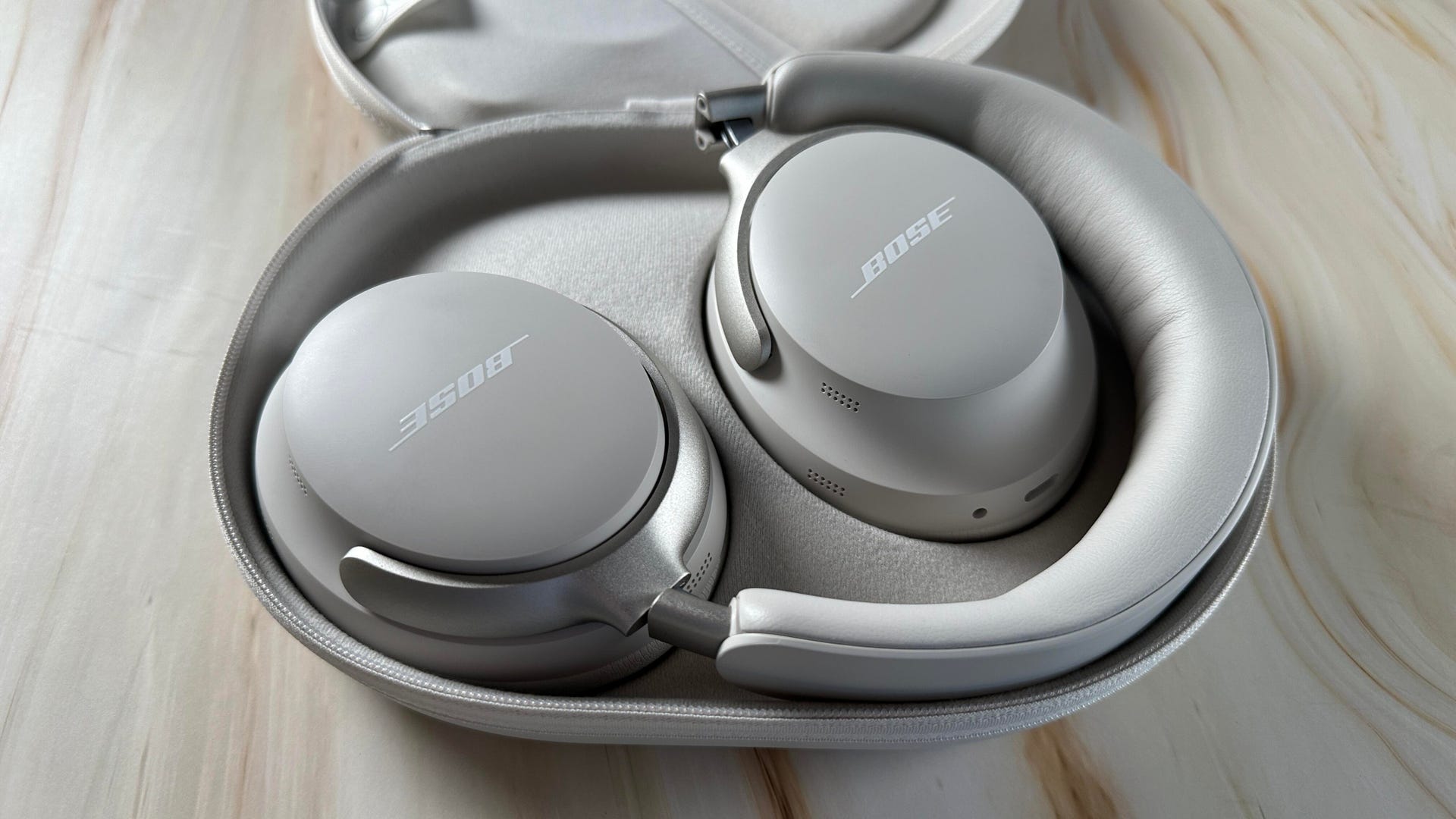
Most people will probably choose to mostly leave it on, but the downside is that engaging it does impact battery life significantly. The headphones are rated for up to 24 hours of battery life at moderate volumes levels with noise canceling on. But the number dips to 18 hours with Immersive Audio engaged.
The aware mode is equivalent to Apple’s transparency mode, and it sounds quite natural with almost no audible hiss. There’s also a new ActiveSense feature that kicks in some ANC should the sound get too loud around you (a horn blast, for instance, or a construction worker’s jack hammer). That’s similar to the AirPods Pro 2’s Adaptive Audio feature that isn’t available for the AirPods Max because it requires Apple’s H2 chip, which isn’t present in that model.
As I said, holding down the multifunction button allows you to toggle through three sound modes. I mentioned the default sound modes, but you can add additional sound modes in the app and then designate three of them as favorites so you can easily toggle through them. When creating a sound mode, you simply customize the level of noise canceling you want (anywhere from none to max) and decide whether you want Immersive Audio (still or motion) activated and wind noise reduction on or off. You can also tweak the sound profile with the app’s equalizer.
Thanks to wear sensors in the ear cups, when you take the headphones off your ears, your audio will pause and resume playback when you put them back on. Beyond that, if you set your headphones down somewhere and forget to turn them off, they’ll go into a sleep mode to conserve battery life. You also have them completely turn off after a set period of time. The default setting is 24 hours, but you can change that in the Bose Music app to as little as five minutes. That sleep mode is similar to the AirPods Max’s power saving features.
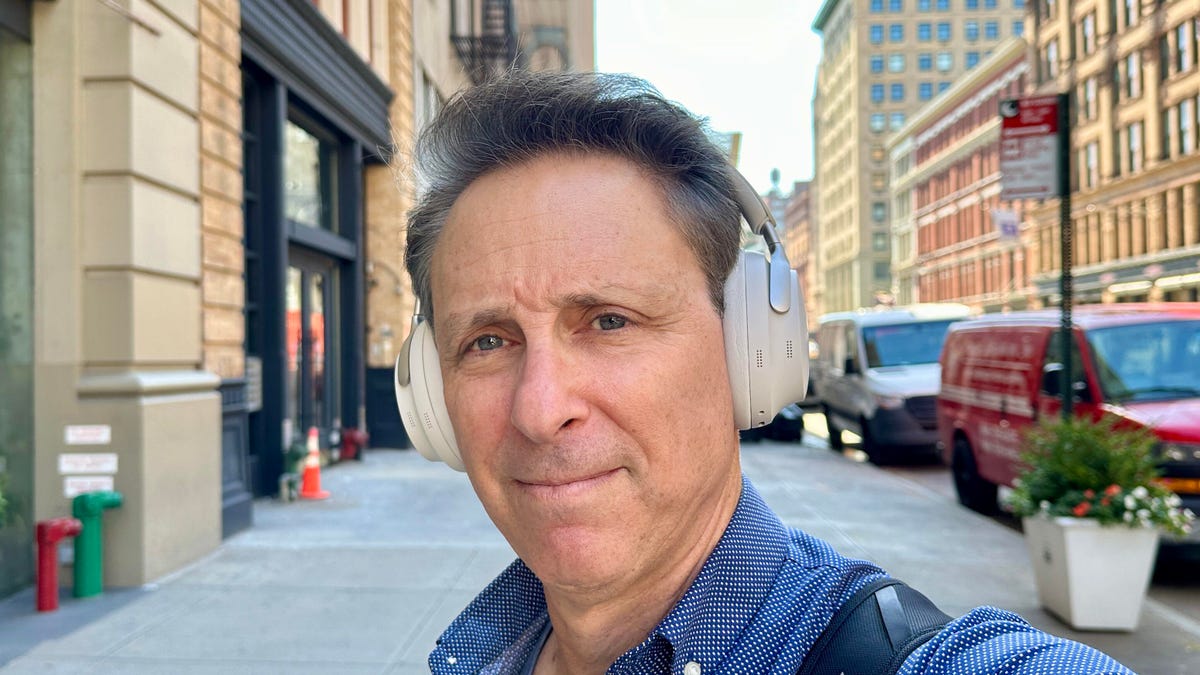
While the QC Ultra Earbuds still lack multipoint Bluetooth pairing — Bose is still working on adding that feature — which allows you to connect to two devices simultaneously and switch audio between them, both the QC Ultra Headphones and QC Headphones have it. I was able to switch back and forth between the audio on an iPhone 14 Pro and an Android device without any issue. The headphones will also pair with your computer, but computer Bluetooth audio can be more finicky, especially with older Windows PCs and Macs.
The QC Ultra Headphones and QC Ultra Earbuds are equipped with Bluetooth 5.3, while the new QC Headphones use Bluetooth 5.1 and lack Bose’s Immersive Audio feature.
Finally, both the Ultra models are LE Audio ready, which means they can be upgraded via a firmware update to include LE Audio features such as Auracast that would allow you to tune into audio broadcasts over Bluetooth, say from a TV at your gym. The LE Audio standard also includes support for the LC3 audio codec.
Modest improvements to already very good sound quality
I spent some time comparing the sound quality of the QC Ultra Headphones to that of the Sony WH-1000XM5 and AirPods Max. While the QC Ultra Headphones have the same drivers as the Headphones 700, the Ultras’ sound has improved from the 700’s. It’s not a huge improvement, but the Ultras’ seem slightly cleaner sounding and more revealing, with deep but well-defined bass. Since they feature the same drivers, most of the audio quality gains come from a more powerful chipset, which has improved digital processing power. Bose also has a feature that optimizes the sound for your particular ears.
Both the Sony XM5 and AirPods Max are excellent sounding headphones and sound quality is subjective, as everybody has different ears and different musical tastes. But I’d say this Bose is a touch ahead of both the Sony and the AirPods Max for sound quality. The Sony has a slightly warmer sound profile, and the Bose just comes across as slightly more natural sounding than the AirPods Max. By that I mean it sounds slightly more accurate.
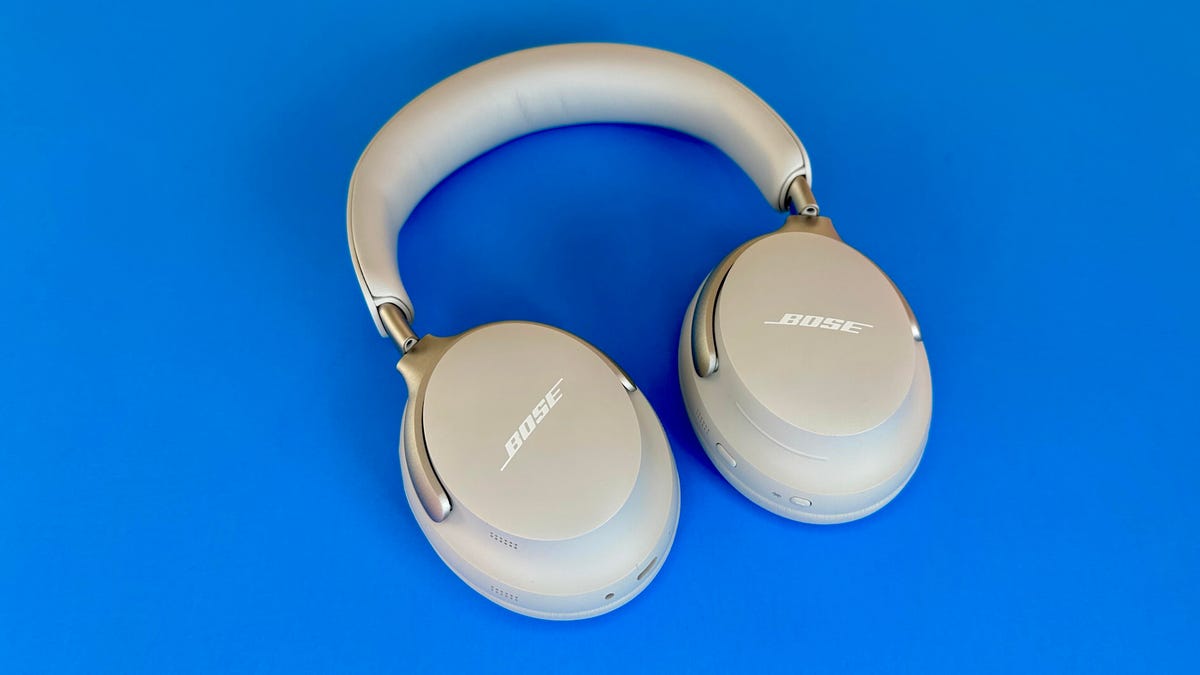
Using the Immersive Audio mode does open up the sound, giving it an airier quality. Everything sounds a little more dynamic and vocals come forward a bit and there’s a bit more separation between instruments with more sparkle in the treble. When you switch back to stereo mode, everything sounds a little duller. You ears eventually adjust and you don’t notice as much, but the natural tendency will be for people to engage the Immersive Audio (whether you choose the still or motion mode is another matter).
For testing, I mainly leave the equalizer at the default flat setting. It’s only a three-band equalizer — you can choose from a few presets or adjust the sliders yourself. Ideally it would be a five-band equalizer, but in years past, Bose didn’t allow you to adjust the sound (there was just the Bose signature sound), so having even this amount of control is a big plus.
The headphones are fairly well-balanced in the default setting. Like Beats, Bose used to get criticized for having some bass push, but that’s not the case anymore. The bass is powerful but not overpowering and it remains tight, even at higher volumes.
I used a few streaming services, including Apple Music, Spotify and Qobuz to listen to tracks and I also plugged the headphone cable in to have a listen in wired mode, both with and without a headphone amp. I didn’t really notice a bump in sound in wired mode, but I need to run some more tests to be sure.
I listened to an eclectic mix of music. Tracks included Spoon’s Knock Knock Knock, Athletes of God’s Don’t Wanna Be Normal, Orbital’s Dirty Rat, Bjork’s Hollow, Drake’s Passionfruit, Pixies’ Vault of Heaven, Florence and The Machine’s Choreomania and various Foo Fighters tracks. The headphones seem well-suited for listening to a variety of music genres.
What I don’t like
I was slightly disappointed the headphones don’t feature USB-C audio. You get a headphone cable for wired listening, which will come in handy for air travel. But with most smartphones now missing a headphone jack, it’d be nice to be able to plug a USB-C cable directly into your phone and have an all-digital wired connection for listening to lossless audio tracks. The Beats Studio Pro and some other headphones offer that feature. And now Android devices and the latest iPhones have USB-C connectivity.
I have one other small gripe. Bose has been using Qualcomm chipsets in its recent headphones, and it says both new QC Ultra models feature Qualcomm’s Snapdragon Sound Technology Suite (QCC5181 chipset) and have support for the aptX Adaptive audio codec, including lossless and low-latency capabilities for Android and other devices that offer aptX compatibility. There’s also Swift Pair for Android, while Apple users get the AAC audio codec, which is also compatible with Android devices. But I had some problems getting aptX to work because it turns out that some leading Android smartphone manufacturers, including Google and Samsung, have stopped paying the licensing fees for aptX.
I paired the headphones with a Google Pixel 7, which supports aptX audio, but it defaulted to the AAC audio code for HD Audio even after I accessed developer mode. (With Android devices, you sometimes have to turn on developer mode to gain access to additional audio codecs.) When I paired them with a Samsung Galaxy Z Flip 5, which is powered by Qualcomm’s Snapdragon 8 Gen 2 chipset, the same thing happened. However, when I connected them to an Asus ROG Phone 6, another Snapdragon-enabled phone, I was able use aptX Adaptive. This inconsistent support is more of a Qualcomm problem than a Bose problem (how can a phone that uses Qualcomm’s top Snapdragon chipset not also support aptX?), but it does impact folks who buy these headphones expecting them to support aptX streaming when in fact it’s not supported by market-leading Android handsets like Samsung’s Galaxy devices.
Great noise canceling and excellent voice-calling performance
I’ll finish by talking about the noise canceling and voice-calling performance. As I said, Bose isn’t talking up the noise canceling as much as it usually does. Maybe that’s because it’s as good as it is and speaks for itself. You can argue over whether Sony or Bose has better noise canceling — and Apple’s is also excellent — but I wore these in the raucous streets of New York and the headphones really muffled everything around me, including people’s voices. It’s top-notch.
Voice-calling performance is also excellent. I was told they have five microphones in each earcup (four external and one inside the earcup) that help drive both the noise-canceling and voice-calling performance. While I was slightly disappointed with how much background noise the QC Ultra Earbuds let in, that wasn’t an issue with these full-size Ultras. Even in noisy environments, callers said they heard only minimal background noise while my voice came through clearly.
If you want to get a sense of the QC Ultra Headphones’ voice-calling performance, I show a test call in my companion video review of these headphones, so check that out.
Why should I get these instead of the AirPods Max?
The AirPods Max are excellent headphones with a uniquely premium design that I rated highly and continue to recommend despite their elevated price. That said, they obviously appeal only to Apple users, while headphones like the Bose QC Ultra Headphones and Sony WH-1000XM5 are more platform-agnostic and have a appeal for both iOS and Android users.
It’s also worth noting that the AirPods Max are almost three years old and are probably due for an upgrade in the coming year. And while they’re surprisingly comfortable given how much they weigh, they’re still pretty heavy and don’t come with a headphone cable for wired listening (you have to purchase the cable separately). On top of that, the QC Ultra Headphones’ case is better than the controversial case that’s included with AirPods Max. The Bose also has slightly better noise canceling and may also have a slight edge for sound quality, depending on your audio tastes. And the Bose does cost a little less.
Why should I get these instead of the Sony WH-1000XM5?
This a bit of a trickier question because I still like the WH-1000XM5s a lot — we gave them an Editors’ Choice award in 2022. The Sony is arguably a touch more comfortable than the Bose and also features excellent sound, great noise canceling and best-in-class voice-calling performance. But the Bose headphones both fold up and fold flat, so their carrying case is smaller, and the Bose arguably has slightly better sound and perhaps a touch better noise canceling. I think the Sony has a slight edge for voice calling but it’s not by much.
I prefer that the Sony has support for Sony’s LDAC audio codec (rather than aptX) and like Sony’s Speak-to-Chat feature that automatically pauses your audio and puts the headphones in transparency mode when you talk to someone, enabling you to have a conversation without taking your headphones off. Apple brought a similar feature to the AirPods Pro 2 — it calls the feature Conversation Awareness — but not the AirPods Max.
Bose’s companion app is more user-friendly than Sony’s, and the new Immersive Audio feature does offer some sound enhancements. How much is debatable, but it’s better than than Sony’s 360 Reality Audio simply because it works with any stereo tracks — not just tracks encoded for 360 Reality Audio.
When all is said and done, the Bose has the slight edge in my book, but the Sony will get the better discounts because it’s been on the market for more than a year and will hold a price advantage over the Bose until it also goes on sale.
Bose QC Ultra Headphones final thoughts
Despite the fact that Bose made a bad decision when it moved away from its QuietComfort branding in 2019 when it released the poorly named Noise Cancelling Headphones 700, that headphone does have a lot of fans. The QuietComfort Ultra Headphones may not be a huge upgrade over the 700 (it has the same drivers after all), it does offer some meaningful improvements both in terms of its design and performance. If I were a 700 owner, I wouldn’t be in a rush to run out in buy if my headphones were still in good condition, but I’d certainly be tempted to upgrade if and when the Ultras go on sale.
I do think the QC Ultra Headphones are a compelling alternative to the Sony WH-1000XM5s and Apple AirPods Max, and also hold a slight edge over such premium models as the Bowers & Wilkins PX7 S2E ($400), another very good set of headphones. If these models are a little out of your price range, the Sennheiser Momentum 4 Wireless, which have dipped to as low as $250 in a sale, are an option. So, too, are the Beats Studio Pro, which dropped to $180 for fall Prime Day and should see discounts during the holidays.
But if you’re looking for the best noise-canceling headphones, the Bose QC Ultra Headphones are certainly at or near the top of the heap, even with their small downsides. Hopefully, over time they’ll get even better with a few firmware upgrades.
Technologies
Need Gift Ideas? Google’s Holiday 100 Shopping List Includes Switch 2, Home Movie Projectors
You can shell out hundreds for a new gaming console or spend less on classic games and backpack charms.

The spooky season has just ended, and Google is already turning its attention to holiday shopping. The search giant just released its annual list of 100 top holiday gift ideas based on the hottest trends of 2025.
The Google Holiday 100 list is an annual shopping guide compiled from searches for various products conducted between May and September. Using that data, Google creates a catalog of the year’s top trending gift ideas across various industries, including tech, toys, fashion and wellness. You can view the entire Google Holiday 100 list here.
Don’t miss any of our unbiased tech content and lab-based reviews. Add CNET as a preferred Google source.
Nintendo Switch 2
This year’s breakaway technology hit was the Switch 2, Nintendo’s latest family-friendly video games console. Unsurprisingly, it appears on 2025’s Holiday 100 list. The console was released in June and has sold more than 10 million units thus far, with Nintendo hiking up sales expectations even among uncertain economic conditions and tariff pricing.
Google Pixel Watch 4
The Google Pixel Watch 4 is a standout wearable that made the Holiday 100 list. Its inclusion isn’t just Google stuffing its own product into a list. If you’re buying a gift for fitness-focused folks, CNET’s Vanessa Hand Orellana wrote that the latest iteration of Google’s smartwatch «hits a sweet spot between universally appealing design, seamless compatibility with the Android ecosystem, potentially life-saving safety features and robust health and fitness tracking.»
Red-light face masks
Your algorithm may have served you up a boatload of red light therapy content from health and beauty influencers this year. Search volume for red light masks has spiked in the past few months, so the LED masks have been included in the Holiday 100 buying guide this year. Just make sure to purchase one of the best FDA-approved masks.
Movie projectors to backpack charms
If you’re looking for gifts across other categories, Google has some top 2025 searches for big and small. Home theaters are apparently in this year, as searches for movie projectors spiked by a whopping 945%. Searches for backpack charms also hit an all-time high this year, so those are a safe bet for stocking stuffing for any young kids.
Checkers (the actual board game)
Even though many gifts given out at Christmas this year will surely be high-tech gadgets and accessories, the board game of checkers is also on the list. There’s always room for the classics.
As you prepare for the Herculean task of yearly holiday shopping, Google’s Holiday 100 is a good place to start. But if you’re looking to beat the crowd on the best tech deals around, CNET is already collecting pre-Black Friday deals.
Technologies
Look Up Tonight to Spot November’s Supermoon, the Brightest Moon of 2025
Has the moon been looking brighter and bigger to you for the past few days? Here’s why this month’s supermoon is even more super.

It’s already a great month for skygazers, with a trio of meteor showers and the return of the northern hemisphere winter constellations. On Tuesday night, it also features the second of four supermoons in a row. This month’s supermoon will happen on Nov. 4-5, and November’s beaver moon is special because it’ll be the brightest full moon of 2025.
In addition to being a supermoon, November’s full moon is known as the beaver moon. There is some debate as to why it was named this way. Some believe that this was the best time of year in the old days to set beaver traps to get pelts for winter clothing. Others believe that it coincides with the busiest part of the year for beavers, who are now stocking their lodges with supplies for the upcoming winter.
Here’s what time it’ll look its biggest and brightest, and what else you need to know about the November supermoon.
Don’t miss any of our unbiased tech content and lab-based reviews. Add CNET as a preferred Google source.
The brightest supermoon: When’s the best time to see it?
The moon will reach peak illumination at 8:19 a.m. ET on Nov. 5, making the evening of Nov. 4 and the morning of Nov. 5 the best times to view the moon.
Since moon phases shift slowly, the moon will appear almost full for nearly a week. If you are unable to view the full moon on its best night due to weather or other reasons, you can still see a mostly full moon at any point from Nov. 3 to Nov. 8.
For all of those days, the moon will be measurably brighter in the night sky compared to any other full moon in 2025. The reason for this is because of the moon’s elliptical orbit. Since it’s not a perfect circle, the moon’s 27.3-day journey around the Earth brings it closer to us on some days, a phenomenon known as perigee. If there is a full moon during this time, it’s branded as a «perigean full moon,» which you may know better as a supermoon.
Not all supermoons are equal, and November’s will be a little more special than others. According to The Farmer’s Almanac, the beaver moon will be a scant 221,817 miles away from Earth, making it the closest full moon of the year. That means it’ll be the biggest and brightest of the year.
In practice, the differences are fairly minor and likely won’t be visible to the naked eye when compared side by side to other supermoons. A supermoon is only about 7% larger than a regular full moon. According to NASA, the biggest difference is when comparing a supermoon to a micromoon, where a supermoon will be about 14% larger and 30% brighter. So, if you notice that your backyard patio is lit up more than usual, it’s because of the supermoon.
Also due to the moon’s orbit, November will also bring a micro new moon, which means the moon will be as far away from the Earth as it can get — a phenomenon known as apogee. November’s new moon occurs on Nov. 20, but you won’t be able to see it.
Technologies
Stay Informed About Your Flights This Holiday Season With Your iPhone’s Tracker
Your iPhone is hiding a flight tracker. Here’s how it works.
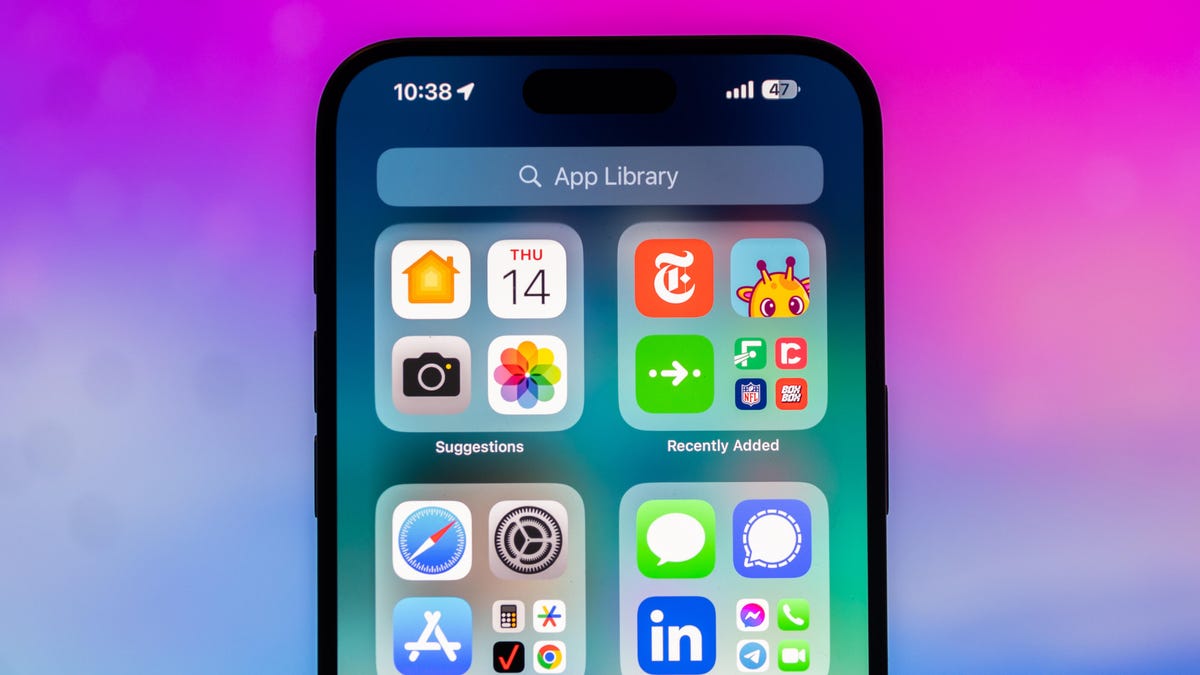
Thanksgiving is only a few short weeks away and if you plan on flying during the holiday season, keeping up-to-date on changes to your flights is crucial. Airports can be hectic during any holiday, but with the government shutdown continuing, flights are liable to change or be cancelled more often.
Luckily, it’s never been easier to get up-to-date information about your flight. For starters, your airline probably has an app, and if not, you can check its website. If you’re in a hurry, you can Google the flight number. Or you can just use your iPhone’s built-in flight tracker that’s sneakily tucked away.
That’s right: Your iPhone has a flight tracker that you may have never known about. It’s there for when it’s needed. Below, we’ll show you have to access it in not one, but two places, so you never have to go hunting for your flight info elsewhere again.
Don’t miss any of our unbiased tech content and lab-based reviews. Add CNET as a preferred Google source on Chrome.
For more on the iPhone, check out everything Apple announced at WWDC 2025.
How to track your flight via iMessage
Before we start, there are a few prerequisites you must meet:
- Make sure iMessage is enabled (it doesn’t work with SMS/MMS).
- You’ll need your flight number somewhere in your text messages, whether you’ve sent that information to someone (even yourself) or it’s been sent to you.
- The flight number must be sent in this format: [Airline] [Flight number], for example, American Airlines 9707.
Launch the native Messages app on your iPhone and open the text message thread that contains your flight information. You’ll know the flight tracker feature works when the text with the flight information appears underlined, which means it’s actionable and you can tap on it.
If your flight is still several months away or it’s already passed, you might see a message that says, «Flight information unavailable.» You might also see another flight that’s not yours because airlines recycle flight numbers.
You can check your flight status from Spotlight Search, too
If getting your flight information from Messages wasn’t easy enough, you can also grab the details right from your iPhone’s home screen by swiping down and adding your flight number into Spotlight Search. Even better, this works with Spotlight Search on your Mac computer, too.
How to access the hidden flight tracker
Although the airline name/flight number format highlighted above is the best way to go, there are other texting options that will lead you to the same result. So let’s say we stick with American Airlines 9707, other options that may bring up the flight tracker include:
- AmericanAirlines9707 (no spaces)
- AmericanAirlines 9707 (only one space)
- AA9707 (airline name is abbreviated and no space)
- AA 9707 (abbreviated and space)
I would suggest you keep the airline name spelled out completely and add a space between the two pieces of information — like in the previous section — because for some airlines, these alternative options may not work.
Real-time flight tracking
Once everything is set, tap on the flight information in your text messages. If the feature works correctly, you should see the following two options appear in a quick-action menu:
- Preview Flight: View the flight’s details. Tap this to view more information about the flight.
- Copy Flight Code: Copy the flight code to your clipboard (in case you want to send your flight details to someone else via text or email).
If you select Preview Flight, at the top of the window, you’ll see the best part of this feature: a real-time flight tracker map. A line will connect the two destinations, and a tiny airplane will move between them, indicating where the flight is at that exact moment.
Underneath the map, you’ll see important flight information:
- Airline name and flight number
- Flight status (arriving on time, delayed, canceled, etc.)
- Terminal and gate numbers (for arrival and departure)
- Arrival and departure time
- Flight duration
- Baggage claim (the number of the baggage carousel)
If you swipe left on the bottom half of the flight tracker, you can switch between flights, but only if there’s a return flight.
For more travel tips, don’t miss our test on whether AI can help you fly more sustainably.
-

 Technologies3 года ago
Technologies3 года agoTech Companies Need to Be Held Accountable for Security, Experts Say
-

 Technologies3 года ago
Technologies3 года agoBest Handheld Game Console in 2023
-

 Technologies3 года ago
Technologies3 года agoTighten Up Your VR Game With the Best Head Straps for Quest 2
-

 Technologies4 года ago
Technologies4 года agoVerum, Wickr and Threema: next generation secured messengers
-

 Technologies4 года ago
Technologies4 года agoBlack Friday 2021: The best deals on TVs, headphones, kitchenware, and more
-

 Technologies4 года ago
Technologies4 года agoGoogle to require vaccinations as Silicon Valley rethinks return-to-office policies
-

 Technologies4 года ago
Technologies4 года agoOlivia Harlan Dekker for Verum Messenger
-

 Technologies4 года ago
Technologies4 года agoiPhone 13 event: How to watch Apple’s big announcement tomorrow
